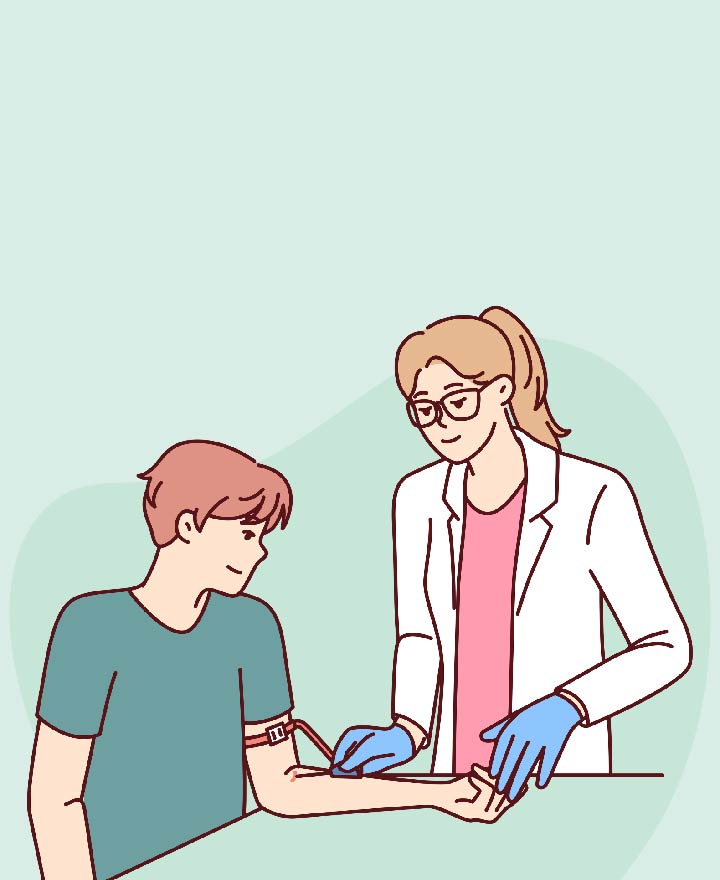

Understanding Leukaemia: Symptoms, Causes and Treatment Options
Leukaemia is a type of cancer that starts in the blood, where the body begins producing an excessive number of abnormal white blood cells (WBCs). These malfunctioning cells can overcrowd the healthy ones and affect their normal function leading to multiple health issues. While the exact cause of leukaemia is not always known, there are several types of the disease, each requiring specific treatment. With early diagnosis and appropriate care, many people can manage leukaemia effectively and lead fulfilling lives. Read on to take a closer look at leukaemia meaning, what causes the condition, the common signs to watch for and more.
What Is Leukaemia?
Leukaemia is a type of cancer of the blood and bone marrow, where the body produces abnormal white blood cells that don’t function properly and multiply uncontrollably. These cells crowd out healthy blood cells, leading to problems with immunity, bleeding, and oxygen delivery.
Symptoms
Symptoms can vary, but often include:
• Fever or chills
• Fatigue or weakness
• Shortness of breath and pale skin
• Getting infections more frequently or more severely
• Swollen lymph nodes or an enlarged liver or spleen
• Bleeding or bruising easily
• Frequent nosebleeds
• Pain or tenderness in the bone
• Losing weight for no clear reason
• Small red spots on the skin (called petechiae)
• Heavy sweating, especially at night
Leukaemia Causes and Risk Factors
Leukaemia happens when the DNA in white blood cells (called leukocytes) changes, causing these cells to grow and divide abnormally. Sometimes, these changed cells avoid the immune system and start growing uncontrollably, taking over the healthy blood cells.
While the exact cause of leukaemia isn’t always clear, certain factors like radiation exposure can increase the risk of developing it.
The following are the risk factors of leukaemia:
• Gender
Men have a higher chance of developing leukaemia compared to women.
• Age
The risk increases as you get older. Most people diagnosed with common types like AML (Acute Myeloid Leukaemia), CLL (Chronic Lymphocytic Leukaemia), or CML (Chronic Myeloid Leukaemia) are 65 or older.
• Blood disorders
Some blood conditions, like polycythaemia vera and myelofibrosis, can increase the chance of developing AML.
• Family history
Leukaemia isn’t usually inherited. However, if you have a close family member with CLL or an identical twin with AML or ALL (Acute Lymphocytic Leukaemia), your risk may be higher.
• Genetic conditions
Certain birth disorders, like Down syndrome and Fanconi anaemia, can raise the risk of AML.
• Smoking
Smoking cigarettes raises the risk of AML, even if it is not a direct cause.
• Radiation
Exposure to high levels of radiation, like from atomic bombs or long-term exposure to low-level radiation (like living near power lines) may increase leukaemia risk.
• Previous cancer treatments
Chemotherapy and radiation therapy used for other cancers can also raise the chance of developing leukaemia.
• Chemicals
Being around certain chemicals, such as benzene or some pesticides, over a long time can increase your risk.
Types and Classifications of Leukaemia
Leukaemia is grouped based on the type of white blood cells affected and how fast the disease grows:
• Lymphocytic leukaemia
This type starts in white blood cells called lymphocytes, which are made in the bone marrow. It is also known as lymphoid or lymphoblastic leukaemia.
• Myeloid leukaemia
Also called myelogenous leukaemia, this type begins in white blood cells other than lymphocytes. It can also affect red blood cells and platelets.
Leukaemia is also described by how quickly it develops:
• Acute leukaemia
It grows quickly and leads to a buildup of immature, non-functioning blood cells in the bone marrow. As a result, the bone marrow can’t make enough healthy blood cells.
• Chronic leukaemia
This type develops more slowly. It causes a buildup of more mature, but still abnormal, white blood cells. It usually takes longer to show symptoms, but it can sometimes be harder to treat
Types
There are four main types of leukaemia, and they are grouped based on how fast they grow and which blood cells are affected:
1. Acute lymphocytic leukaemia (ALL)
This type is most common in kids, teens and young adults under 40.
2. Acute myelogenous leukaemia (AML)
AML usually affects adults, especially those over 65.
3. Chronic lymphocytic leukaemia (CLL)
CLL mostly affects older adults (over 65). It grows slowly, so symptoms might not show up for years.
4. Chronic myelogenous leukaemia (CML)
This type is more common in older adults but can occur at any age. It is rare in children, and symptoms often take several years to show up.
Diagnosis
Routine blood tests can sometimes detect signs of leukaemia before symptoms appear. If symptoms are present, your doctor will recommend further tests to diagnose the condition.
Common tests include:
• Physical exam
Your doctor will check for signs like swollen lymph nodes, an enlarged liver or spleen, bleeding gums or skin rashes.
• Complete blood count (CBC)
This test checks the levels of red and white blood cells and platelets. Abnormal results may point to leukaemia.
• Blood cell tests
Additional blood tests, like a peripheral smear or flow cytometry, can help detect leukaemia cells and identify the type.
• Imaging tests
X-rays, CT scans or MRIs may be done if there is concern that leukaemia has affected organs or bones. While leukaemia itself doesn’t usually show up on scans, these tests can help spot changes caused by the disease.
• Bone marrow biopsy
A small sample of bone marrow fluid (usually from the hip) is taken with a needle to look for leukaemia cells. This test confirms the diagnosis and shows how advanced the condition is.
• Lumbar puncture (spinal tap)
If needed, doctors may test spinal fluid to check if leukaemia has spread to the brain or spinal cord.
Treatment
The treatment depends on the type of leukaemia you have, along with other factors like your age, overall health and whether the cancer has spread.
Common treatments include:
• Chemotherapy
Chemotherapy is a common treatment that uses drugs to kill leukaemia cells or stop them from growing. These medicines can be taken as pills or given as injections, and they are often combined to work more effectively.
• Radiation therapy
This treatment uses high-energy rays to destroy leukaemia cells or stop their growth. Sometimes, radiation targets specific areas or the whole body, especially before a stem cell transplant.
• Immunotherapy
This treatment helps boost your immune system so it can better recognise and fight leukaemia cells.
• Targeted therapy
Targeted therapy uses drugs that focus on specific parts of leukaemia cells (like a gene or protein), stopping them from growing or killing them directly. This treatment is less likely to damage healthy cells.
• Stem cell transplant
Stem cell transplant replaces damaged bone marrow with healthy stem cells. These cells can come from your own body or from a donor to help your body produce healthy blood cells again.
• CAR T-cell therapy
A CAR T-cell therapy is a new treatment that uses your own immune cells (called T-cells). These cells are changed in a lab to better recognise and attack leukaemia cells, then put back into your body to help fight the cancer.
Impact on Health and Lifestyle
Leukaemia can affect your health and lifestyle in many ways, such as:
• Ongoing fatigue even after treatment
• Weakened immune system
• Emotional effects about cance relapse
• Financial strain because of long-term treatments and regular checkups can sometimes lead to financial stress.
• Physical side effects from chemotherapy or radiation.
How Leukaemia May Affect Health Insurance Eligibility
Leukaemia can affect your health insurance eligibility in the following ways:
• Pre-existing condition
Leukaemia is seen as a pre-existing condition, so some insurance companies might not offer full coverage right away, or they may have waiting periods before certain treatments are covered.
• Higher premiums
If you do get coverage, the premium might be higher because of the increased health risk.
• Limited plan options
Some private insurers may not accept people with a history of leukaemia, especially if the condition was diagnosed recently or is still active.
• Medical check-ups required
Insurers may ask for detailed medical records, recent tests, and doctor reports before approving your application.
• Waiting periods
Even if your policy is approved, treatments related to leukaemia might not be covered right away. You may have to wait 1-4 years before certain benefits kick in.
Conclusion
Getting a leukaemia diagnosis can be tough for you and your family. However, with timely treatment and the right support, it can be managed. It is also a good idea to check your health insurance, as treatment can take time and be expensive. Having the right cover can ease the financial burden and give you peace of mind during such challenging times.
One of the important components of our overall wellness is also being financially secured. Healthcare emergencies can happen any time, but a good health insurance policy can protect you from such uncertain situations. To know more about Wellness and other health related tips, visit the wellness corner.
Disclaimer: This blog provides general information and discussions about health and related subjects. The information and other content provided in this blog, website or any linked materials are not intended and should not be considered or used as a substitute for medical advice, diagnosis, or treatment. Kindly contact your doctor before starting a new medicine or health regime.
Related Articles
Causes of Hairy Cell Leukaemia
Spleen Cancer: Causes, Symptoms and Treatment Guide
What tests are done to check for cancer?
Be aware of cancer signs and symptoms
Symptoms of Leukaemia in Children
Published on July 14, 2025















 Health Insurance
Health Insurance  Travel Insurance
Travel Insurance  Car Insurance
Car Insurance  Cyber Insurance
Cyber Insurance  Critical Illness Insurance
Critical Illness Insurance
 Pet Insurance
Pet Insurance
 Bike/Two Wheeler Insurance
Bike/Two Wheeler Insurance  Home Insurance
Home Insurance  Third Party Vehicle Ins.
Third Party Vehicle Ins.  Tractor Insurance
Tractor Insurance  Goods Carrying Vehicle Ins.
Goods Carrying Vehicle Ins.  Passenger Carrying Vehicle Ins.
Passenger Carrying Vehicle Ins.  Compulsory Personal Accident Insurance
Compulsory Personal Accident Insurance  Travel Insurance
Travel Insurance  Rural
Rural